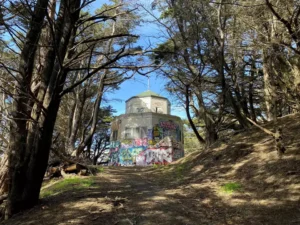Most stories will tell you that San Francisco has two octagon homes. Both are pristinely maintained historic landmarks and sometimes even open for tours. But a third, often forgotten eight-sided house sits abandoned among the cypress woods on the cliff tops of Lands End.
The unusually shaped home on the hill above the Cliff House was once one of the most important structures in San Francisco. Officially named the Point Lobos Marine Exchange Lookout Station, the building’s sole purpose was to let the city know who was sailing toward the bay.
A lookout station existed at Lands End as far back as 1852, when hundreds of vessels filled with gold-fevered crew set sail for the Golden Gate. Initially, the means of communication from the lookout involved a semaphore system wherein raised wooden arms were angled to denote the type of vessel sailing in. The signal would be seen by a second station in the Presidio, and relayed on over the hills to Telegraph Hill, letting the downtown businesses know a ship was approaching, historian John Martini wrote in his 2009 essay.
By 1927, when the Octagon House was built just up the hill from a previous lookout station, a telephone and radio system accomplished the same goal.
Eight-sided houses were somewhat of a fad in Victorian times, but the trend never gained real popularity. Downsides to octagonal life included awkward triangle-shaped rooms, doors that cut off other rooms when opened, and their tendency to collapse in natural disasters. The home at Lands End was one of the last octagons to be built, likely due to the 360-degree view the shape provided from the top floor.
A garage occupied the ground floor, as it does today; a living quarters filled the second floor, and above that, the lookout room with a giant telescope was centered inside a surrounding balcony. At the time, no trees shrouded the view over the Pacific.

The first tenant of the building was a seafarer named Julius Larsen and his young family. Norwegian by birth, Larsen reportedly sailed around the world three times before settling in San Francisco.
A look at Larsen’s unique day-to-day life was revealed in a 1931 newspaper profile.
“When a ship thrusts its funnel over the horizon 32 miles off the Golden Gate Julius Larsen can look through his 12-foot glass and tell the name of the far-distant vessel,” the story read.
Larsen claimed he could name any boat by looking at its smokestack as it passed the Farallon Islands. He would then relay this information to the San Francisco Chamber of Commerce by telephone, so businesses such as hotels and the immigration department could be readied across the city at the Embarcadero.
Larsen’s nightwatchman, and eventually his successor, was a man named William Morrissey. William became part of the family when he married Larsen’s daughter, Annie. William and Annie would live and work in the building with their four children for decades.
Due to technological advancements, the station’s equipment was put out of commission in 1968, but the National Park Service allowed the Morrisseys to continue to rent the residence for $25 a month. The park service, however, likely did not expect her tenancy to last into the 21st century.

“Thankfully nobody has asked us to move,” Annie told reporters in 1974, a year before William’s death. “We just wouldn’t know where to go after all these years.”
Long after the building had no use, and her husband had died, Annie Morrissey would climb the spiral staircase to the third floor, take her binoculars, step through the door onto the balcony, and look over the seas.
“It’s a lifelong habit, I can’t resist, could you?” she told the LA Times in 1983. “There’s always something fascinating out there on the water.” She added that she had occasionally spotted fishing boats in distress and called the Coast Guard, continuing her late husband and father’s family tradition.
